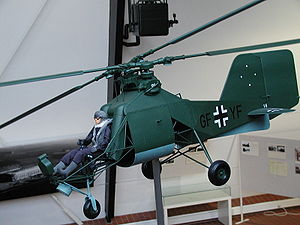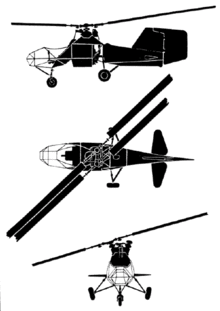Flettner Fl 282
| Flettner Fl 282 Hummingbird | |
|---|---|
 Model of the "Kolibri" on a scale of 1: 4.6; to be seen in the helicopter museum Bückeburg and Aeronauticum |
|
| Type: | Experimental helicopter |
| Design country: | |
| Manufacturer: | |
| First flight: |
October 30, 1941 |
| Commissioning: |
October 14, 1942 |
| Number of pieces: |
more than 20 |
The Flettner Fl 282 Kolibri was a small German military helicopter from the time of the Second World War , which was used as a reconnaissance and airborne scout. It was the first helicopter to be built in series and one of the first helicopters with which significant flight performance could be achieved.
The most striking feature was the Flettner double rotor , which uses two counter-rotating, intermeshing rotors and therefore does not require a tail rotor for torque compensation . This gave rise to the name Kolibri , because the turning movement of the rotors, when viewed from the front or back, is reminiscent of the fast flapping of a hummingbird 's wings .
Design features and equipment
A preliminary data sheet from December 23, 1943 shows two variants: the Fl 282 B-0 and Fl 282 B-1, whereby the B-0 had an uncovered driver's seat, while the B-1's driver's seat was covered with plexiglass . The fuselage was built in a fabric-covered grid structure made of steel tubes. According to this data sheet, control was carried out by periodic or constant changes in the angle of attack of the rotor blades (known today as cyclical and collective rotor blade adjustment). It was possible to switch manually between helicopter and gyroplane operation - if the engine failed, the operation was automatically switched to gyroplane operation. A bomb magazine for two 5 kg explosive devices as well as a magazine for smoke buoys was planned for the border patrol. The special facilities included three electrically operated explosive bolts for the jump start.
Development history and testing
Anton Flettner had been working on the development of helicopters for some time. The predecessor of the Fl 282 was the Fl 265 , which was also equipped with a Flettner double rotor. The construction of the Fl 282 began presumably as early as 1939. After several attempts to tie the helicopter to the ground with ropes, Ludwig Hofmann carried out the first free flight on October 30, 1941 with the Fl 282 V2. With the V3 at the end of April 1943 heights of up to 3800 meters could be reached. Various modifications were necessary as part of the testing, including the tail unit , the cladding of the upper gearbox and the glazing of the cabin. On the V9, flight tests could even be carried out with only the front part of the fuselage - without the tail. A similar variant was later to operate from submarines as Fl 282 U. With the V21 and V23, a variant with an additional seat in the rear fuselage was tested.
The Navy in particular showed great interest in this aircraft from an early stage. The tests were therefore carried out at the test center in Travemünde , whose air traffic control ship "Greif" was also able to carry out tests on a ship's deck from August 1942. During these attempts, however, a helicopter, the V17 (CJ + SK), broke. In this context, there have also been attempts to use it for fighting submarines by dropping bombs. Investigations in which the Fw 190 fighter plane should be used to evaluate the chances of hitting a Fl 282 were also remarkable . The helicopter could be sighted briefly at altitudes over 100 meters, but this was hardly possible near the ground. The "Kolibri" also proved to be quite insensitive to fire.
The exact number of test aircraft is not known, based on the documents that have been handed down, it must have been at least 23.
The Reich Aviation Ministry (RLM) was of the opinion that Flettner was not able to carry out sufficient series production. Flettner himself resisted giving up production. At times it was considered to transfer the series production to a Flettner employee, if necessary forcibly.
Use in the Navy
At the beginning of the war, the navy was already planning the use of helicopters from ships or submarines. In April 1940, the naval command saw helicopters such as the Fl 265 and the Fl 282, which was still in development, as an ideal basis for defending against the increased occurrence of enemy submarines. A helicopter would have been ideal for use in the Navy, which otherwise relied on large, inflexible aircraft on board , not least because it could return safely to the ship even in bad weather, i.e. high waves. It was calculated that ten helicopters could be set up in the same space that was required for a conventional on-board aircraft. High priority was also given to a smaller variant with a cylindrical hull that could be launched from submarines. Since the responsibility for development and production lay with the Luftwaffe, but the helicopter was of much less importance to them, the Navy was unable to advance the development with the desired urgency. In April 1942 an initial need for 50 ship-based helicopters was announced, another 40 for anti-submarine combat and some Fl 282 U for large submarines. This requirement was later increased to a total of 110 helicopters. The existing production capacities could not cope with these large numbers, however.
The navy also initiated the trials in the front on the Mediterranean operating mine ship Drache , which began in November 1942. In February 1943, the "Kolibri" was certified as an on-board aircraft and for fighting submarines. In April / May 1942 an additional successful test of the Fl 282 for suitability for submarine hunting was carried out in the Baltic Sea.
Airborne squadron 3./196
On October 14, 1942, the on-board flight squadron 3./196 was set up, the main task of which was to test helicopters such as the Fl 282 and the Fa 330 as so-called "special on-board aircraft". As part of the experiments carried out by this squadron, a man was picked up from a rubber dinghy and set down on land during a simulated emergency at sea.
At the end of February 1944, Erhard Milch ordered the shutdown of helicopter production because the capacities were to be used to manufacture fighter planes . The flight squadron 3./196 was finally disbanded in June 1944.
Large series order for the army
Towards the end of 1942 / beginning of 1943 the army accidentally learned of the Fl 282 when a helicopter was made available for General Kurt Zeitzler as part of a vehicle demonstration . Thereupon the army registered an order for 1000 helicopters - the air force however resisted the idea of having to provide the necessary resources for the army.
In April 1943, however, 150 Fl 282 B were shown in a delivery schedule of the RLM; Material for another 500 was released. The production should take place at BMW in Eisenach. In the next edition of the delivery program from October 1943, however, production was withdrawn again.
After the end of the war
Two Fl 282s came to the USA as spoils of war , from a third only the frame construction with the upper gearbox came to England . There it is still on display in the Midland Air Museum in Coventry . The very successful testing influenced the further development of the helicopter by the Kaman company , where the K-MAX is still a helicopter with intermeshing rotors.
Technical specifications
| Parameter | Flettner Fl 282 B |
|---|---|
| crew | 1 |
| Hull length | 6.15 m |
| height | 2.40 m |
| Trunk width | 2.40 m |
| Rotor diameter | 12.00 m |
| Empty mass | 715 kg (B-0) or 735 (B-1) |
| Takeoff mass | 955/980 kg (B-0) or 975/1000 kg (B-1) |
| Top speed forward | 80 km / h * |
| Backward maximum speed | 30 km / h |
| Top speed sideways | 20 km / h |
| Top speed as a gyroplane | 60 km / h * |
| Service ceiling | 1500 m ** |
| Range | 168 km |
| Engine | a BMW / Bramo 314 E with 118 kW (160 PS), a Siemens Sh 14 built by Bramo |
| Armament | two 5 kg bombs |
* According to the preliminary data sheet of December 23, 1943, these are temporarily limited maximum speeds for reasons of strength.
** The altitude was also temporarily restricted according to the above document, but altitudes of up to around 4,100 meters are said to have been flown.
literature
- Yves Le Bec: The True Story of the Helicopter. From 1486-2005. Jean Ducret Publishing House, Chavannes-près-Renens 2005, ISBN 2-8399-0100-5 .
- AIRPLANE Profile No. 14 Flettner Fl 282 KOLIBRI variants. VDM Heinz Nickel, Zweibrücken.
Web links
Individual evidence
- ↑ s. Le Bec, p. 10
- ^ Steve Coates: German helicopters 1930–1945. Stuttgart 2004, p. 85.
- ↑ Preliminary data sheet Fl 282 B-0 and B-1 of the E -stelle Travemünde from December 23, 1943

